clocks and watches

Figure 1. An Egyptian clepsydra.
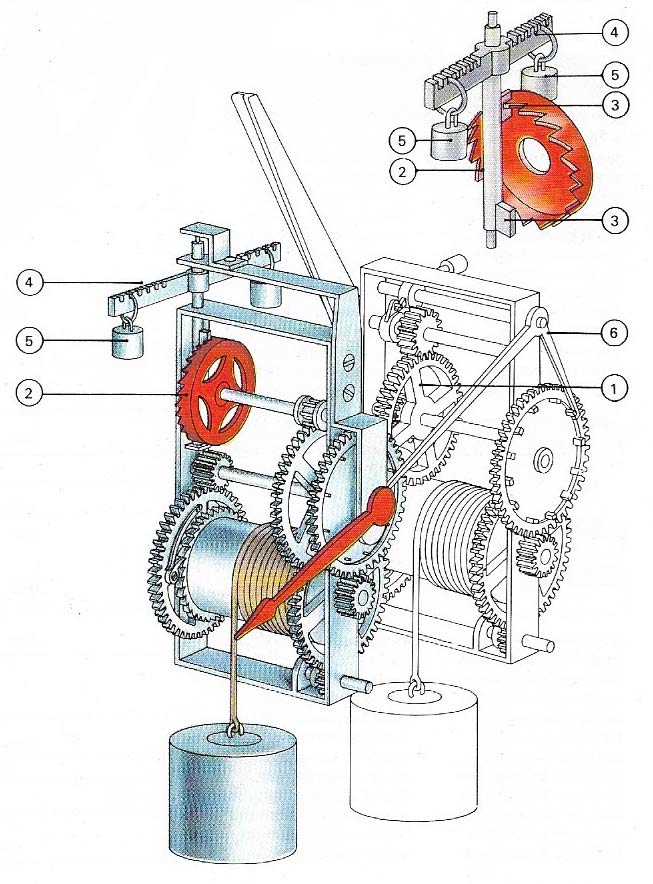
Figure 2. Henry de Wyck was commissioned in 1370 to build a clock for Charles V's palace in Paris. It is a good example of early mechanical striking clocks operated by falling weights. As they fall the weights set gear trains (1) in motion. The crown wheel (2) actuates the pallets of the verge escapement (3) so causing oscillations of the balance (4). Two inertial weights(5), suspended from the bar balance, can be adjusted to control the rate of the bar's oscillation. The gear train actuates the single dial hand. A second train of gears leading to the striking device is set in motion by a lever (6) actuated by a pin on the hour-hand wheel.
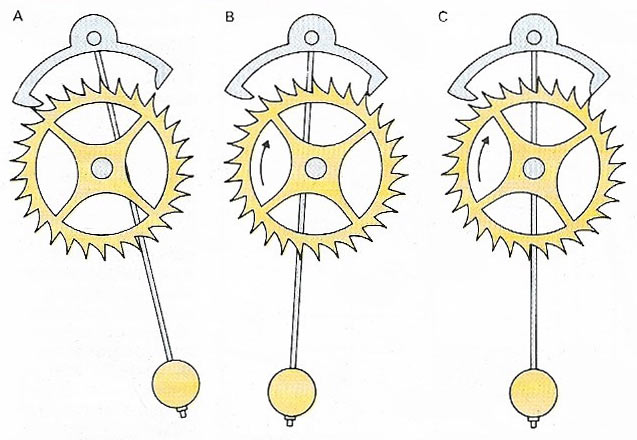
Figure 3. The accuracy of a mechanical clock depends above all on the escapement mechanism which releases the energy of a spring or weight regularly in small bursts to the time-keeping part of the clock. The anchor escapement of a pendulum clock (A) has an anchor that swings about its center and is connected to the pendulum. A main spring (not shown) moves the escape wheel clockwise. A tooth of the wheel pushes one pallet of the anchor (B) until the other pallet checks another tooth (C) the curve of the pallet forcing the wheel slightly backward. After this recoil the pallet receives a push until the first pallet checks the wheel. In this way, the to-and-fro movement maintains the pendulum's oscillations.
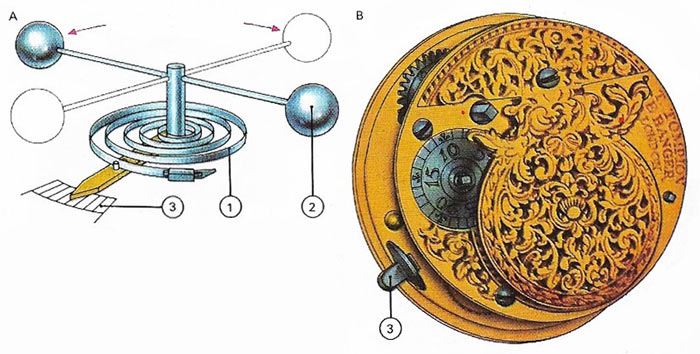
Figure 4. This seventeenth-century watch (B) has its balance spring (1) attached to the staff of a balance (2) which swings first one way, then the other, under the tension of the spring (A). The regulator (3) shortens or lengthens the spring to alter its tension, which in turn controls the swings and so the accuracy of the watch.

Figure 5. Harrison's No.4 chronometer.
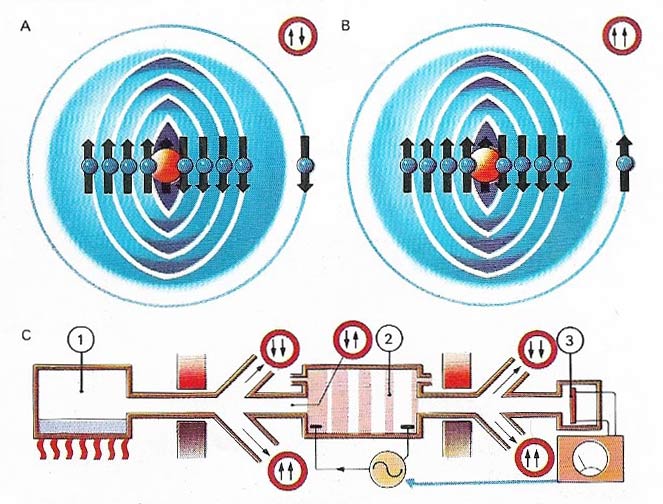
Figure 6. Atomic clocks use the frequency of vibration of atoms (about 10 billion per second) to regulate a quartz crystal clock. Cesium atoms (A) are normally unmagnetized but radiation can magnetize them (B). A cesium clock (C) has a boiler (1) giving a supply of atoms whose magnetic axes are lined up by a magnetic field. In the chamber (2) they encounter an oscillating field and the magnetic axes flip over so that they are deflected by a second magnetic field toward a detector (3). Signals from here control a quartz crystal clock.
Clocks and watches are devices to indicate or record the passage of time, which have become essential features of modern life. In prehistory, time could be gauged solely from the position of celestial bodies; a natural development was the sundial, initially no more than a vertical post whose shadow was cast by the Sun directly onto the ground. Other devices, notably the clepsydra (Figure 1), depended on the flow of water from a pierced container; the rates at which marked candles, knotted ropes, and oil in calibrated vessels burned down; and the flow of sand through a constriction from one bulb of an hourglass to the other.
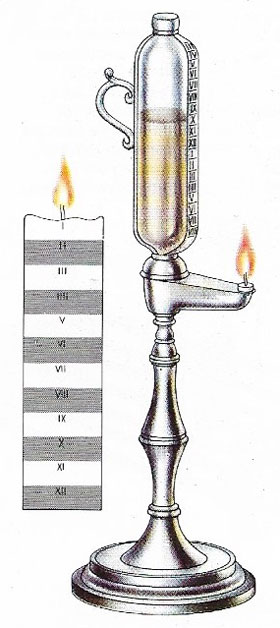 |
| The oil clock was a sixteenth century development of the candle clock first known among the Anglo-Saxons. Both have a scale recording the dropping level in hours as the oil or wax burns away. |
Early mechanical clocks
Mechanical clocks were probably known in ancient China, but first appeared in Europe in the 13th century AD. They were driven by falling weights which moved gear-wheels (Figure 2). For the clock to run for more than a few seconds, the power from the falling weights must be released slowly. To do this, one of the gears (the escape wheel) is regularly "held" and released. The mechanism that achieves the controlled release of power in a clock or watch is called the escapement.
Early clocks used the verge escapement. Two projections or pallets, formed on the balance axis, engaged with and disengaged from the teeth of the escape wheel, causing the balance to oscillate regularly. The motion of the escape wheel was transmitted to a single hand on the clock face.
As driving mechanisms, falling weights have the obvious disadvantage of not being easily portable. As early as the mid-fifteenth century, compact and portable clocks driven by springs were developed.
Early spring-driven clocks were inaccurate. A minute hand had appeared on the faces of some of these clocks, but a hand telling the seconds remained almost unknown until the arrival of the pendulum.
Around 1657–1658, the Dutch scientist Christiaan Huygens , influenced by a suggestion by Galileo, specified the conditions for a perfectly swinging pendulum and applied it to a clock. From this time, more accurate clocks were made with pendulums.
Problems with pendulums and escapements
Problems of accuracy remained. Pendulums are affected by changes in temperature, which cause them to expand or contract and so change length. In about 1715 George Graham invented the first of many pendulums compensated for temperature changes. Three hundred years ago, however, the principal shortcoming of clock mechanisms were the verge escapement, which interfered with pendulum action. In 1673 a new type, the anchor escapement (Fig 3), was invented. It allowed a heavy pendulum to swing in a small arc with such a gain in accuracy that it is still fitted in some clocks.
Another oscillator is the balance and balance spring, or hairspring (Fig 4). One end of the spiral balance spring is fixed and the other end is attached to the axis of the balance. The balance spring alternately winds and unwinds as the balance swings.
The balance spring was also introduced by Huygens, in 1675, an he later incorporated it in a watch that he intended to be used for determining longitude at sea. But balance springs, like pendulums, were adversely affected by temperature variations. It was not until 1753 that an effective compensation was made for a watch by John Harrison (1693–1776) whose chronometer of 1759, made in response to a government competition, erred by only five seconds in a sea voyage lasting six weeks (Fig 5). Accuracy had also been improved by the introduction of jewels as bearings. They reduce friction in the bearings and are extremely hard wearing. Sapphires and rubies were, and still are, the jewels generally used.
Electric clocks with synchronous motors are now commonly found in the home and office, while the atomic clock (Fig 6), which can be accurate to within one second in 3 million years, is of great importance in science.
Special types of clock
Astronomical clock
An astronomical clock is a highly accurate clock that keeps either sidereal time or Universal Time. Formerly, such instruments were checked by timing the passage of clock stars across the meridian using a meridian or transit circle and a book of clock errors. Today, atomic clocks are used instead.
Atomic clock
An atomic clock is a clock that uses the resonance frequencies of atoms to keep time with extreme accuracy. The electronic components of an atomic clock are regulated by the frequency of microwave radiation that is emitted or absorbed by the quantum transition (energy change) of an atom or a molecule. In atomic clocks, quantum transitions produce extremely regular waves of electromagnetic radiation. Clocks that run on the radiation from hydrogen atoms, for example, lose only one second in about 1,700,000 years.
Chronometer
A chronometer (Figure 4) is an extremely accurate clock, especially one used in connection with celestial navigation at sea (see also celestial sphere). It differs from an ordinary clock in that it has a fusee, by means of which the power transmission of the mainspring is regulated such that it remains approximately uniform at all times; and a balance made of metals of different coefficients of expansion to minimize the effects of temperature changes. The device is maintained in gimbals to reduce the effects of rolling and pitching. A chronometer's accuracy is checked daily and its error noted; the daily change in error is termed the daily rate.
Chronometers are always set to Universal Time (Greenwich Mean Time). The first chronometer was invented by John Harrison (1735).
Clepsydra
A clepsydra, also known as a water clock, is an instrument in which the discharge of water from a storage tank is monitored in order to measure the passing of time (Figure 2). Clepsydras were used from ancient times until the Renaissance. "Clepsydra" is Greek for "water thief."
Hourglass
A hourglass is an ancient instrument to measure the passage of time. A quantity of fine, dry sand is contained in a bulb constricted at its center to a narrow neck. The device is turned so that all the sand is in the upper chamber: the time taken for the sand to trickle into the lower chamber depends on the amount of sand and on the diameter of the neck.
>
 |
| 17th century hourglass in the Istituto e Museo di
Storia della Scienza, Florence.
|
Sundial
A sundial is a device for showing apparent solar time by the position of a shadow cast by an indicator called a gnomon. The gnomon slants upwards away from the dial at an angle determined by the latitude; it points due north in northern latitudes and due south in southern latitudes. Sundials were first used in the Near East about 5,000 years ago.
>
 |


